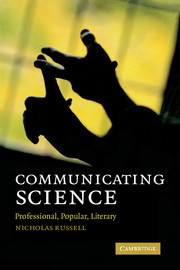Book contents
- Frontmatter
- Contents
- Introduction: What this book is about and why you might want to read it
- Prologue: Three orphans share a common paternity: professional science communication, popular journalism and literary fiction are not as separate as they seem
- Part I Professional science communication
- Part II Science for the public: what science do people need and how might they get it?
- Part III Popular science communication: the press and broadcasting
- Part IV The origins of science in cultural context: five historic dramas
- Part V Science in literature
- 20 Science and the Gothic: the three big nineteenth-century monster stories
- 21 Science fiction: serious literature or low grade entertainment?
- 22 Science in British literary fiction
- 23 Science on stage: the politics and ethics of science in cultural and educational contexts
- Index
- References
22 - Science in British literary fiction
Published online by Cambridge University Press: 02 December 2010
- Frontmatter
- Contents
- Introduction: What this book is about and why you might want to read it
- Prologue: Three orphans share a common paternity: professional science communication, popular journalism and literary fiction are not as separate as they seem
- Part I Professional science communication
- Part II Science for the public: what science do people need and how might they get it?
- Part III Popular science communication: the press and broadcasting
- Part IV The origins of science in cultural context: five historic dramas
- Part V Science in literature
- 20 Science and the Gothic: the three big nineteenth-century monster stories
- 21 Science fiction: serious literature or low grade entertainment?
- 22 Science in British literary fiction
- 23 Science on stage: the politics and ethics of science in cultural and educational contexts
- Index
- References
Summary
Self-consciously modernist writers of the early twentieth century such as Henry James, Joseph Conrad or Virginia Woolf held that a novel should be a work of art and an end in itself. They argued against those like H.G. Wells and Aldous Huxley who believed that novels should be means to ends, commenting and critiquing the human condition with a view to changing or improving it. We know from the subsequent reputations of these writers which position most literary commentators have taken. To use a cricketing analogy, James and Conrad are opening batsmen for genius, while Huxley and Wells are sloggers well down the order in the second 11. Subsequent modernists have followed James, such that literary art was set up in opposition to science, an argument rehearsed in two famous historical spats; T.H. Huxley's duel with Matthew Arnold in the nineteenth century, and the infamous F. R. Leavis/C. P. Snow ‘two cultures’ row in the mid twentieth century.
The great polymath immunologist, Sir Peter Medawar, questioned the validity of the myth underlying the whole dispute, that imagination and reason are antithetical, or independent ways of understanding the world. He argued that they are complementary and, in science at least, both are essential. The idea of their mutual hostility arose from serious mistakes made by thinkers on both sides. Those who favoured the rapid insights of creative imagination overdid their propaganda that truth derived through reason was slow and trivial. Reductionist philosophers of science compounded the false dichotomy by claiming that rational analysis was the only tool used in science. […]
- Type
- Chapter
- Information
- Communicating ScienceProfessional, Popular, Literary, pp. 283 - 300Publisher: Cambridge University PressPrint publication year: 2009



